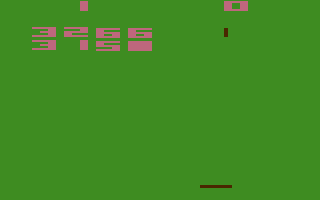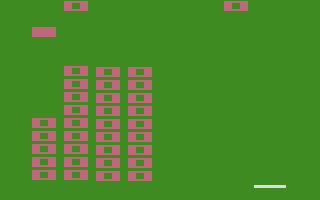Retro Replay Review
Gameplay
Codebreaker delivers a deceptively simple yet deeply engaging puzzle experience by challenging players to deduce a hidden 3- or 4-digit code in a limited number of attempts. Whether you’re playing against the computer or another human opponent, the core loop of entering guesses, receiving feedback, and refining your strategy keeps each round fresh and thrilling. The two difficulty settings—8 or 12 guesses—allow newcomers to acclimate before taking on seasoned codebreakers who thrive under stricter constraints.
(HEY YOU!! We hope you enjoy! We try not to run ads. So basically, this is a very expensive hobby running this site. Please consider joining us for updates, forums, and more. Network w/ us to make some cash or friends while retro gaming, and you can win some free retro games for posting. Okay, carry on 👍)
The feedback system is elegantly conveyed: correct digits in the correct position, correct digits in the wrong position, or no matches at all. This straightforward mechanic rewards deductive logic and pattern recognition, encouraging players to track possibilities on paper or in their minds. Over successive games, you’ll discover subtle techniques—such as balancing exploratory guesses with safe guesses—that elevate your success rate and maximize points.
Adding further variety is the Nim variation, which transforms Codebreaker from a solitary logic test into a head-to-head strategy duel. In Nim, you and your opponent take turns removing items from one or more stacks, with the victor determined by who claims or avoids the last item, depending on the chosen rule set. This two-player minigame injects a fresh strategic dimension, making Codebreaker feel like a compilation of classic mind sports rather than a single-mode puzzle title.
Overall, the gameplay loop in Codebreaker strikes an excellent balance between approachability and depth. Quick to learn but hard to master, it suits both casual puzzle enthusiasts looking for a few minutes of brain-teasing fun and competitive players who thrive on refining their tactics. The inclusion of both single-player codebreaking and multiplayer Nim ensures that boredom is never an option, as each mode offers its own brand of intellectual challenge.
Graphics
Visually, Codebreaker adopts a clean, minimalist aesthetic that prioritizes clarity over flash. The game board presents digits and feedback markers in high-contrast colors, ensuring that each clue stands out immediately. While the graphics won’t win any awards for photorealism or flashy effects, they serve the core gameplay impeccably, letting you focus on deduction rather than deciphering UI elements.
The transition animations—numbers sliding into place, markers flipping to reveal results—are subtle but satisfying. These small touches add a sense of polish without overstaying their welcome, reinforcing the feeling of incremental progress as you strip away possibilities. On modern screens the interface scales crisply, preserving the retro puzzle-board charm without introducing jagged edges or pixelation.
Although Codebreaker does not feature elaborate backgrounds or character designs, the simplicity works in its favor. There are no distracting environmental details; instead, the game’s visual restraint emphasizes logic and concentration. Colorblind-friendly palettes are also an option, ensuring that players with visual impairments can enjoy the full experience without missing crucial feedback cues.
The Nim variant follows the same design principles, rendering stacks of items as neat icons that are easy to count and remove. Whether you choose the classic remove-last-to-win or the twist where taking the last item causes defeat, the visual clarity remains intact. This straightforward presentation reinforces strategic thinking, letting you zero in on your next move rather than juggling convoluted menus or overly ornate graphics.
Story
Codebreaker does not offer a traditional narrative or character-driven storyline; instead, it invites players to craft their own mental journey through puzzles. The lack of a plot may deter those seeking a fully immersive saga, but it also removes any padding, keeping the focus squarely on cerebral engagement. For puzzle purists, this absence of fluff is a welcome design choice.
Rather than weaving through cutscenes or dialogues, players experience a narrative of discovery and triumph with each solved code or won Nim match. Every feedback marker feels like a line in an unfolding story of logic, where you play the protagonist deciphering hidden secrets. In that sense, Codebreaker’s “story” is purely intellectual, unfolding in real time on the board before you.
For those who crave context, the minimalist presentation can serve as a blank canvas. Some players invent spy-themed scenarios—cracking enemy safe codes or defusing digital bombs—while others see each round as a detective mystery. This open-ended approach lets your imagination fill in the gaps, making every session feel personalized.
Although there’s no overarching campaign or character progression, Codebreaker’s silent narrative rewards consistency and improvement. Tracking your high scores, perfecting your deduction techniques, and mastering Nim strategies all contribute to a sense of personal achievement. In the absence of cutscenes, the true storyline is the one you write through each clever guess and strategic removal.
Overall Experience
Codebreaker offers a refreshingly pure puzzle experience that appeals to both newcomers and seasoned logic game aficionados. The combination of code-guessing and Nim ensures that boredom is kept firmly at bay, as each mode taps into different strategic skill sets. Whether you have five minutes or an hour, the adjustable difficulty and two distinct game variations provide a puzzle fit for any timeout scenario.
The interface’s visual clarity and responsive controls make every guess feel immediate and satisfying. Although there’s no flashy spectacle, the game’s refined polishing—from crisp number animations to colorblind safeguards—underscores a commitment to quality that fans of cerebral gaming will appreciate. Multiplayer matches via hotseat or digital link add a social layer, transforming Codebreaker into a perfect party icebreaker for puzzle-loving friends.
While purists might lament the absence of a dramatic storyline, the game’s self-directed narrative of logical triumph is more than compensation. Achieving a perfect codebreak in minimal moves or outsmarting an opponent in Nim brings its own brand of exhilaration, proving that great gameplay can be its own story. The challenge is never contrived, and the gratification of success is instant.
In sum, Codebreaker stands out as a sleek, intelligent package that makes every minute spent puzzling worthwhile. Its clean presentation, thoughtful difficulty options, and dual-game modes result in a comprehensive brain-bending toolkit. For anyone seeking a digital pastime that sharpens the mind without unnecessary frills, Codebreaker delivers a compelling, endlessly replayable experience.
 Retro Replay Retro Replay gaming reviews, news, emulation, geek stuff and more!
Retro Replay Retro Replay gaming reviews, news, emulation, geek stuff and more!







Reviews
There are no reviews yet.